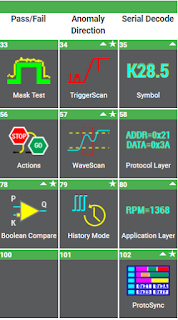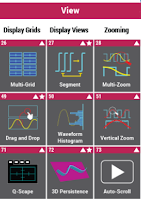 |
| Figure 1: A probe's impedance varies with frequency |
You need to test, we're here to help.
You need to test, we're here to help.
14 December 2017
Probing Techniques and Tradeoffs (Part V): Probe Loading
06 December 2017
Probing Techniques and Tradeoffs (Part IV)
 |
| Figure 1: Applying bandwidth filters to a 2.5-GHz clock signal clearly shows the effect of bandwidth on rise time |
27 November 2017
Probing Techniques and Tradeoffs (Part III)
 |
| Figure 1: Bandwidth is defined as the frequency at which the ratio of the displayed amplitude to the input amplitude is -3 dB (or 0.707) |
The frequency at which the ratio of the displayed amplitude to the input amplitude is -3 dB (or 0.707).
This is known as the "-3 dB point," or the half-power point (Figure 1). At this frequency, a sine-wave input signal is attenuated to 70.7% of its true amplitude. Any higher frequencies will likely be distorted on the display, making accurate measurements and calibration impossible.
20 November 2017
Probing Techniques and Tradeoffs (Part II)
 |
| Figure 1: A snapshot of available probes from Teledyne LeCroy |
15 November 2017
Probing Techniques and Tradeoffs (Part I)
 |
| Figure 1: Probes are the signal's gateway to the oscilloscope |
30 October 2017
The Power Integrity Measurement Mindset
 |
| Figure 1: The holistic view of power integrity |
24 October 2017
Automotive Ethernet Compliance: Test Equipment Requirements
 |
| Figure 1: The TF-ENET-B Ethernet test fixture offers all necessary interconnects for compliance test |
17 October 2017
Automotive Ethernet Compliance: Tests in Detail (Part IV)
 |
| Figure 1: The specified pass/fail mask for the transmitter power spectral density test |
12 October 2017
Automotive Ethernet Compliance: Tests in Detail (Part III)
 |
| Figure 1: This depicts the setup for the Automotive Ethernet transmitter distortion test |
19 September 2017
Automotive Ethernet Compliance: Tests in Detail (Part II)
 |
| Figure 1: Testing transmitter timing master jitter entails creating a track of TIE measurements |
13 September 2017
Automotive Ethernet Compliance: Tests in Detail (Part I)
 |
| Figure 1: Maximum transmitter output droop should not exceed the specified maximum of 45% |
08 September 2017
Automotive Ethernet Compliance: Test Setup Overview
 |
| Figure 1: Typical test setup for Automotive Ethernet PMA compliance test |
30 August 2017
Automotive Ethernet Compliance: The Five Test Modes
 |
| Figure 1:Automotive Ethernet electrical compliance test is defined at the connector of the transmitter |
24 August 2017
Introduction to Automotive Ethernet Compliance Testing
As with most any networking scheme, Automotive Ethernet is subject to standardization to ensure that the various components of a given system reliably pass signals among themselves. Where there is a standard for a protocol, there must also be testing for compliance with that standard. This will be the first in a series of posts detailing compliance test of the Physical Media Attachment (PMA) aspect of the Automotive Ethernet standard.
17 August 2017
Back to Basics: Metrology
Some sciences are more obscure than others; these may be of interest and importance to relatively few. The term “metrology” may leave even some science geeks scratching their heads, but for those in the test and measurement arena, metrology is an extremely critical area of scientific endeavor.
27 July 2017
The Periodic Table of Oscilloscope Tools: Document
Oscilloscope users can find themselves managing a lot of detail in the course of driving their instruments. They need to keep track of instrument setups. They have to know standards-based compliance test routines backward and forward. Often, the need arises to remotely control the oscilloscope, interface it with other applications, and export/import acquisition data. And, importantly, the oscilloscope has to aid, and not hinder, collaboration with other members of the engineering team(s).
And thus we arrive at the end of our survey of the Periodic Table of Oscilloscope Tools with the Document portion.
And thus we arrive at the end of our survey of the Periodic Table of Oscilloscope Tools with the Document portion.
- Hardcopy: Use the oscilloscope's Print button to pre-define a documentation action and execute that action with the press of one button. Select to create a file of a screen image in a variety of formats; send an email with an attached screen image; copy data to a clipboard; print a document; or save the waveform data, screen images, panel setups, and the end user's annotations as a LabNotebook (see below).
26 July 2017
The Periodic Table of Oscilloscope Tools: Analyze (Part III)
We're nearing the end of our tour of the Periodic Table of Oscilloscope Tools, our way of presenting our broad palette of oscilloscope tools in a concise, clear fashion. In this installment, we'll finish up the Analyze grouping, by far the largest on the Periodic Table.
20 July 2017
The Periodic Table of Oscilloscope Tools: Analyze (Part II)
 |
| Figure 1: The Analysis tools in an oscilloscope lend it debug power |
18 July 2017
The Periodic Table of Oscilloscope Tools: Analyze (Part I)
 |
| Figure 1: Analysis tools deepen insight into waveform behavior and relationships |
14 July 2017
The Periodic Table of Oscilloscope Tools: Math
 |
| Figure 1: DSP-based Math functions can reveal deep insights hidden in waveforms |
12 July 2017
The Periodic Table of Oscilloscope Tools: Measure
 |
| Figure 1: Measure tools are at the heart of an oscilloscope's utility |
07 July 2017
The Periodic Table of Oscilloscope Tools: View
 |
| Figure 1: The View tools arrange acquisition data to suit given needs |
05 July 2017
The Periodic Table of Oscilloscope Tools: Capture
 |
| Figure 1: The Periodic Table of Oscilloscope Tools is a handy reference to oscilloscopes' capabilities |
29 June 2017
Distinguishing BroadR-Reach and 100Base-T1
 |
| Figure 1: BroadR-Reach provides full-duplex operation over a single twisted pair of wires |
27 June 2017
The Basics of Automotive Ethernet Testing
 |
Figure 1: Automotive Ethernet
PHY test requires 1-GHz bandwidth
and 2-GS/s sample rate minimum
|
20 June 2017
VIDEOS: Exploring MAUI with OneTouch
 |
| Figure 1: MAUI with OneTouch makes child's play of complex oscilloscope operations |
19 June 2017
Why Automotive Ethernet?
 |
| Figure 1: The MOST infotainment protocol offers a higher aggregate bandwidth than Automotive Ethernet, but its 150-Mb/s bandwidth is shared across the network |
14 June 2017
Fundamentals of the BroadR-Reach Protocol
 |
| Figure 1: BroadR-Reach delivers bandwidth of 100 Mb/s |
12 June 2017
Back to Basics: Automotive Ethernet
 |
Figure 1: Automotive Ethernet handles
a wealth of functionality
|
30 May 2017
An Inside Look at an Automotive Ethernet Seminar
 |
| Figure 1: Students gain first-hand experience in Automotive Ethernet protocol testing |
19 May 2017
Testing the DDR Memory Interface's Physical Layer (Part IV)
 |
| Figure 1: Probes are a key element of the total signal acquisition system |
24 April 2017
Testing the DDR Memory Interface's Physical Layer (Part III)
 |
| Figure 1: For analysis purposes. it's critical to separate read and write bursts of interest |
11 April 2017
Testing the DDR Memory Interface's Physical Layer (Part II)
 |
| Figure 1: Shown is a typical BGA package for DDR memory |
05 April 2017
Testing the DDR Memory Interface's Physical Layer (Part I)
 |
| Figure 1: Clock, strobe, and data are three critical signals in DDR test |
29 March 2017
Fundamentals of the DDR Memory Interface
 |
| Figure 1: A representative test setup for physical-layer DDR testing |
20 January 2017
Back to Basics: Three-Phase Sinusoidal Voltages
 |
| Figure 1: Three-phase AC voltages consist of three voltage vectors |
Subscribe to:
Comments (Atom)
